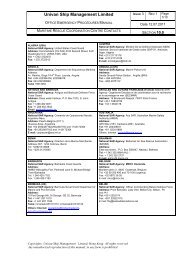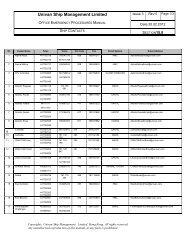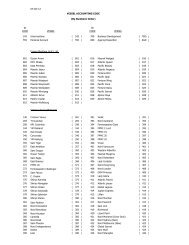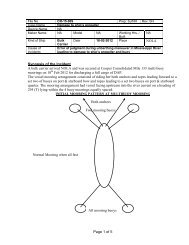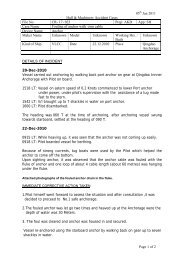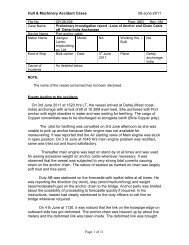Section: 11 CARGO OPERATIONS - Univan
Section: 11 CARGO OPERATIONS - Univan
Section: 11 CARGO OPERATIONS - Univan
You also want an ePaper? Increase the reach of your titles
YUMPU automatically turns print PDFs into web optimized ePapers that Google loves.
<strong>Univan</strong> Ship Management Limited Issue 1 REV 0 Page<br />
2/7<br />
FLEET OPERATION MANUAL Date 01.01.2005<br />
<strong>CARGO</strong> SECURING PROCEDURES<br />
Copyrights: <strong>Univan</strong> Ship Management Limited, Hong Kong. All rights reserved<br />
Any unauthorized reproduction of this manual, in any form is prohibited<br />
SECTION <strong>11</strong>.4<br />
When the cars are stowed in athwart ship direction, we require taking minimum 3<br />
lashings at each end.<br />
The athwartship stowed vehicles should also be secured with the wooden wedges,<br />
pressed underneath the front of the front wheels and behind the rear wheels.<br />
If the car is stowed in such a position that the angle between the lashings is more than<br />
120 degrees, a third lashing should be taken in between the two.<br />
A lashing should never extend underneath another vehicle, since it may be touching any<br />
part of the vehicle. And when the lashing touches a part of the car body, which is not a<br />
designed lashing point, it may cause damage to that particular part.<br />
End of the lashing with shortest distance to the buckle (lock) should be fixed on the deck.<br />
Two join to short lashing; they should be connected by the hook to the hook. Fixing the<br />
hook to another part of the lashing is not permitted.<br />
Hooks should never be affixed to the buckle (lock) of another lashing, as this may cause<br />
the buckle to break or snap off.<br />
Vehicle should be individually lashed and under no circumstances they should share a<br />
lashing.<br />
If the lashing point on a vehicle , e.g. in the front on most of the Mercedes Benz models<br />
and Chrysler Jeep Cherokee, is placed inside the bumper, spoiler or any other part of<br />
the vehicle, polyester slings (straps) or steel hooks (specially designed for Mercedes<br />
Benz) should be placed between the lashing and the lashing point.<br />
If Polyester slings or straps are used one strap should be used for each lashing.<br />
The polyester sling and the straps should be strong and of same Safe working load as<br />
the lashing itself. The damaged straps and polyester slings should be disposed off.<br />
Sling should not be tied to the vehicle, but the end to be passed through the lashing point<br />
and both the ends should be connected to the hook of lashing clasper.<br />
It is prohibited to affix any lashing hooks to any part of the vehicles, such as bumpers,<br />
fenders, steering rods and wheel rim etc.<br />
Certain cars may require the specific lashing procedures, those must be followed. They<br />
may vary from case to case basis.<br />
Some of the cars may be without proper lashing points, which is the case with several<br />
American models, the shipper may be able to advise you the specific slots on the chassis<br />
of the vehicle, where you may affix the hooks. In the absence of any such slots the<br />
lashing may be taken through the wheel rims.<br />
The hooks should not be affixed directly to aluminum rims, they should be connected<br />
through the strap or polyester sling.<br />
If the rim has a sharp edge, then padding should be given below the strap. This will<br />
prevent the strap to be damaged during the voyage.<br />
The following pages we are presenting you some picture, to refresh what ever you have<br />
studies so far on car lashings.



